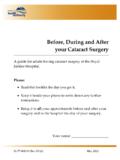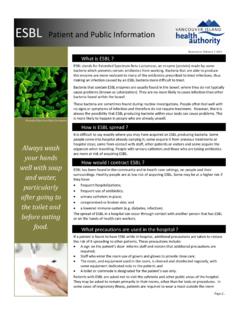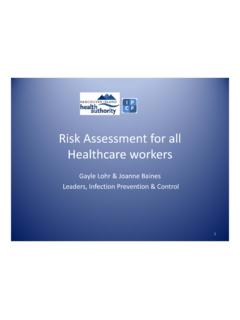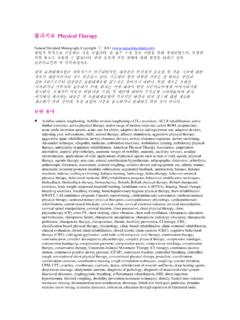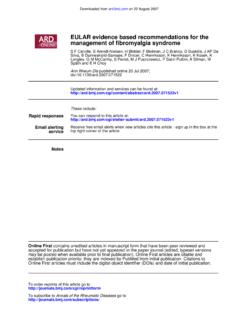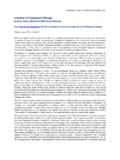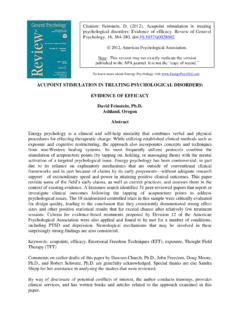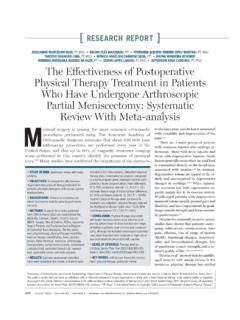Transcription of Occupational Therapy and Physical Therapy …
1 Standard Number: Effective Date: Interprofessional Practice & Clinical Standards Policy Guideline Protocol Procedure Plan of Care Professional Responsible/For Use By: Occupational Therapy and Physical Therapy Title: Seating/ Mobility Assessment Procedure Indications: A. The purpose of this Seating/Mobility Assessment Procedure is to provide step by step directions to perform assessment tasks, and gather and analyze information when recommending seating and/or mobility equipment for purchase, long-term use or for complex clients. B. Assessment Requirements: This Seating/ Mobility Assessment has been modularized to allow for flexibility with prescribing seating/ mobility devices for different purposes. Please see the decision tree on page 2 to ensure that the appropriate sections of the Seating/ Mobility Procedure and Documentation Standard are being used.
2 Write N/A on the assessment form if there are boxes not applicable to the client position in current seating system - if they do not already have a seating system. For example, when prescribing a manual wheelchair for transportation purposes, look on the decision tree. Note that the only sections of the Seating/ Mobility Assessment Documentation form a therapist needs to use to document the prescription process for a transport wheelchair are: Section 1 - General Information and Client Goals; Section 5 Analysis and Recommendations, and Section 6 Outcomes. Section 2 only needs to be done if the therapist does not already have an assessment on the chart (such as an Initial Assessment) that takes into account the client s functional abilities in relation to wheelchair use transfers, environment, transportation, etc. Relevant, current assessment information already in the client record does not need to be duplicated.
3 This information must be referenced on the General Information and Client Goals form Section 1. C. Goals must be based on functional issues. Use your clinical judgment. Care Outcomes: To achieve a standardized seating assessment process for seating/mobility prescription that: Is evidence based; is client centered; and promotes consistency of care within VIHA. Supports practitioner competency. Reduces repeat funding of equipment. Ensures best equipment match to meet client needs. Definitions: Long Term Use: use of seating/mobility equipment for more than 6 months. Complex clients: have multiple functional and Physical issues requiring custom and/or customized commercial seating/mobility equipment. Relevant Implications: These are the So What?? areas on the form where the therapist notes issues to be considered when choosing seating and mobility equipment, if a client does a standing pivot transfer and you have noted the optimal seat to floor height, this is a Relevant Implication for the equipment choice OR if your client travels by accessible van, you need to be aware of the limitations of the van lift with respect to weight and size of mobility device.
4 Title: Seating Procedure - Revised Oct. 15th 2004 Page 2 of 20 Decision Tree for Documenting Required Sections of Seating and Mobility Assessment Client purchasing own mobility device and/or who will be using a mobility device long term. Client goals for mobility. New or replacement mobility device. Power Mobility Manual wheelchair Transport wheelchair Complete sections: 1. General information and client goals, 2. Functional assessment (or indicate in Section 1 if functional assessment currently on chart), 5. Analysis and recommendations, and 6. Outcomes. Manual wheelchair for primary mobility Complete sections: 1. General information and client goals 2. Functional assessment (or indicate in Section 1 if functional assessment currently on chart), or Physical assessment, 4. Current mobility and seating system (if pertinent), 5. Analysis and recommendations, and 6. Outcomes.
5 Scooter Complete sections: 1. General information and client goals 2. Functional assessment (or indicate in Section 1 if functional assessment currently on chart), 4. Current mobility and seating system (if pertinent), 5. Analysis and Recommendations For Part C just need to do #10, and 6. Outcomes Power wheelchair for primary mobility Complete sections: 1. General information and client goals 2. Functional assessment (or indicate in Section 1 if functional assessment currently on chart), or Physical assessment, 4. Current mobility and seating system (if pertinent), 5. Analysis and recommendations, and 6. Outcomes. Power wheelchair vs. Scooter Consider: Storage Building access elevator, stairs Vehicle transportation issues Sitting balance Positioning needs Indoor vs. Outdoor needs Hand function Ability to transfer Prognosis/ Diagnosis Funding issues Title: Seating Procedure - Revised Oct.
6 15th 2004 Page 3 of 20 Section 1 General Information and Client Goals A. General Information Client Information Basic information about the client. B. Client/ Caregiver Concerns and Goals for Seating Identify client s/caregiver s primary concerns and functional difficulties reason for change in equipment. Outline client/ caregiver goals of new seating system. Section 2 Functional Assessment A. Weightbearing/ Transfers and Lifts Walking: With or without aid, type of aid, tolerance, terrain. Any impact on type of wheelchair? Crutch/cane holders necessary on wheelchair? Transfers: Client must be able to bear some weight during the move. Comment on method/equipment used, assistance required, number of times/day, optimal seat to floor height, type of armrest support needed, or do armrests need to be removable. These factors impact on decision for type of wheelchair frame and design.
7 Lifts: Client does not bear any weight. Comment on equipment used, assistance required, mechanical vs. non-mechanical. Is a lift sling left under the client this may be a positioning issue. Is more than one person available or necessary to assist with positioning the client after the lift. B. Wheelchair Mobility Manual: Stroller: Power mobility: Comments: Indicate method of propulsion and/or provide further description. Comment on type of terrain client encounters, distances that need to be traveled and endurance/strength of client. If client is dependent on caregiver for mobility, indicate caregiver limitations. These factors impact on decision for: a) type of wheelchair frame and design more durable vs. lightweight frame; rigid vs. folding frame, degree of adjustability needed in frame, tilt; b) type of power mobility scooter, midwheel drive, rear wheel drive c) type of rear wheels and front casters pneumatics vs.
8 Solids, size of front casters. These factors are also important for supporting your rationale with funding agencies. C. Self Care Method of eating: Does the client feed him/herself or is assistance required. Are eating aids used? Access to tables? Does the eating set-up/equipment required impact wheelchair components? Bowel & bladder management: Continent vs. incontinent, toileting routine/schedule, equipment. Access to toilet? Assistance required. Does the set-up/equipment required impact wheelchair components? Other activities of daily living (ADL/IADL): Comment on other aspects of ADL that may be affected by wheelchair/seating components. Comment on set-up required for maximum independence or ease of caregiving. Use of technology and environmental controls should be noted. D. Work/ School and Leisure Describe client s activities.
9 Is seating and mobility limiting these activities? Title: Seating Procedure - Revised Oct. 15th 2004 Page 4 of 20 E. Perceptual/ Cognitive Status Vision: Hearing: Functional cognitive ability: Cognitive/ perceptual testing: Comment on general cognitive/perceptual ability ie. vision, visual perception, hearing as related to safe wheelchair operation. Also note client s orientation (to person/place/time) and ability to remember where he/she is and safely travel on their own. Motor planning can the client plan and execute complex motor function? Cognition are there any cognitive issues that will impact client s ability to operate wheelchair safely? ( ability to problem solve) For power mobility, more detailed/formalized cognitive/perceptual assessment may be necessary. Refer to the VIHA Power Mobility Safety Toolkit which includes the North Shore Health Region Power Mobility Assessment in the Community Tool.
10 F. Communication Verbal vs. non-verbal. Communication aids, adaptive technology used. How is volume of speech or use of equipment affected by head and body position? What is the ideal position and access set-up for function? Is a tray needed? How will technology equipment be mounted? G. Environment 1. Home Accessibility Entrances: Stairs/ Ramps: Elevator: Flooring: Table heights: Access: Charging Area: Home Accessibility: Describe living environment as indicated on the worksheet. Does the current seating system limit access to the environment? Home environment may impact the chair chosen with respect to type, size or turning radius. Community Accessibility: Any accessibility issues? How will the overall size of the wheelchair impact their community/vocational activities? 2. Transport Method of transport: Method of loading: Comment on type of vehicle used ( car, van, taxi, accessible bus system, public transit etc.)

